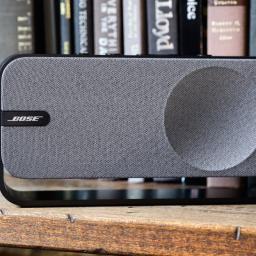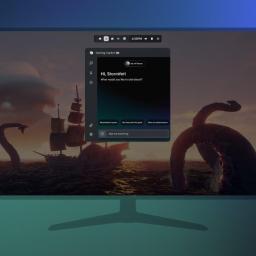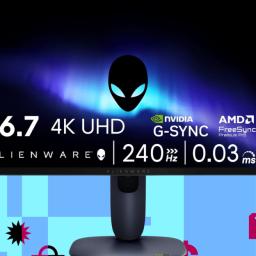 |
by Emma Roth on (#6Z588)
Google says its AI search features aren't tanking website traffic despite recent reports suggesting otherwise. In a blog post published on Wednesday, Google Search head Liz Reid says click volume from the search engine has remained relatively stable" when compared to the same time last year - though some types of websites are getting more [...]
|
The Verge
| Link | https://www.theverge.com/ |
| Feed | http://www.theverge.com/rss/index.xml |
| Updated | 2025-11-09 01:47 |
 |
by Brandt Ranj on (#6Z55D)
Audio quality is always going to be a speaker's most important feature, but it doesn't hurt if it looks nice too. In our tests, Bose's SoundLink Home is a solid sounding, aesthetically pleasing portable Bluetooth speaker that you can currently pick up for $199.99 ($20 off) from Amazon, Best Buy, and Bose. The SoundLink Home's [...]
|
 |
by Jay Peters on (#6Z55C)
To better protect against cheaters, Activision says that Call of Duty: Black Ops 7 players on PC will need to use hardware with Trusted Platform Module (TPM) 2.0 and have Windows' Secure Boot feature turned on when the game is available later this year. Ahead of that, Activision is doing a phased rollout" of the [...]
|
 |
by Tom Warren on (#6Z55E)
Microsoft started testing its Xbox Copilot on iOS and Android earlier this year, and now it's bringing the chatbot to the Game Bar feature on Windows 11. Xbox Insiders can start testing a preview of the Gaming Copilot integration in the Game Bar today, and Microsoft is planning further optimizations" for this new feature on [...]
|
 |
by Kara Verlaney on (#6Z55F)
Today, I'm excited to announce three newsletter offerings, exclusive to Verge subscribers, that will continue to deliver must-read stories about tech and beyond. First, we're introducing Regulator by Tina Nguyen. Regulator is focused on the battles between Big Tech and Big Government - from the juicy palace intrigue to the devastating consequences of their political [...]
|
 |
by Tina Nguyen on (#6Z55G)
You'll often see tech policy reporting described as the intersection of technology and politics, and for years, that was a pretty accurate description: Silicon Valley existed independent of Washington politics, and every so often, they'd cross paths, discuss some regulatory concern, write a check, shake hands, and then go their separate ways. This is no [...]
|
 |
by Marina Galperina on (#6Z55H)
I'm excited to announce The Stepback, a weekly subscriber-only newsletter that I'll be editing for The Verge. We'll be bringing you a new story each Sunday from a rotating cast of writers from every corner of the Verge extended universe. If you're a regular reader, you know we cover a broad range of topics across [...]
|
 |
by Cameron Faulkner on (#6Z523)
Nintendo recently made the unexpected decision to increase the prices of its last-gen Switch hardware due to market conditions," adding $30 to the cost of the $199.99 Switch Lite, $40 to the standard $299.99 Switch, and $50 to the $349.99 Switch OLED. The price difference between the Switch OLED and the standalone Switch 2 now [...]
|
 |
by Emma Roth on (#6Z524)
Disney is planning to fully integrate Hulu with Disney Plus, creating a unified" app experience that will launch next year, the company announced as part of its earnings results on Wednesday. The new app will put all of Hulu's content into Disney Plus, calling the future of Hulu's standalone app into question. With Disney's deal [...]
|
 |
by Andrew Liszewski on (#6Z525)
Since its launch in 2022, the capabilities of Sonos Voice Control have expanded to include setting timers and checking the weather. But by the end of this year, the smart assistant will introduce compatibility with the Philips Hue smart home platform allowing it to also control lights through voice commands, according to Hueblog. In late [...]
|
 |
by Mia Sato on (#6Z526)
Instagram is getting several new features that pull from competitors, and it's updating a controversial feature that it added earlier this year. Starting today, users will have the ability to repost public Reels and grid posts from other accounts. And similar to TikTok, reposts will be collected in a designated tab on your profile and [...]
|
 |
by Justine Calma on (#6Z4YT)
These days, Paducah, Kentucky - population 27,000 and home to the National Quilt Museum - prides itself as "Quilt City." But decades ago, it was also called the "Atomic City" - a moniker it could soon regain as AI's energy needs bring Paducah's nuclear past back to life. The Department of Energy (DOE) operated a [...]
|
 |
by Robyn Kanner on (#6Z4YV)
Jeff Buckley captivated an audience of generations with his transcendent voice and soaring guitar. After his untimely passing in 1997 at age 30, he gained posthumous, cult-like status. Never one for the charts, his album Grace has stood the test of time and is listed on Rolling Stone's 500 Greatest Albums of All Time. His [...]
|
 |
by Dominic Preston on (#6Z4YW)
Disney announced that it will no longer report on subscriber numbers for its streaming services in its quarterly financial reports, following in the footsteps of Netflix. The decision comes after a quarter in which it reported 2.6 million new Disney Plus and Hulu subscribers, bringing it to 183 million in total. The decision was announced [...]
|
 |
by Emma Roth on (#6Z4YX)
The launch of ESPN's long-awaited standalone streaming service is just weeks away. Alongside its earnings results on Wednesday, Disney revealed that ESPN's streaming service and its enhanced" app will arrive on August 21st for $29.99 per month. ESPN's new streaming service, which remains separate from ESPN Plus, will offer access to the network's linear channels, [...]
|
 |
by Dominic Preston on (#6Z4WM)
Nvidia's chief security officer has published a blog post insisting that its GPUs do not and should not have kill switches and backdoors." It comes amid pressure from both sides of the Pacific, with some US lawmakers pushing Nvidia to grant the government backdoors to AI chips, while Chinese officials have alleged that they already [...]
|
 |
by Tom Warren on (#6Z4WN)
OpenAI released a new free and open GPT model yesterday that can run on a PC, and now Microsoft is making that easy to do for Windows users. The lightweight gpt-oss-20b model is now available on Windows AI Foundry, and will be coming soon to macOS, too. You'll need a PC or laptop with at [...]
|
 |
by Tom Warren on (#6Z4WP)
Researchers have already found a critical vulnerability in the new NLWeb protocol Microsoft made a big deal about just just a few months ago at Build. It's a protocol that's supposed to be HTML for the Agentic Web," offering ChatGPT-like search to any website or app. Discovery of the embarrassing security flaw comes in the [...]
|
 |
by Jay Peters on (#6Z4M1)
Google's August Pixel update includes a fix for Android's three-button navigation and gesture navigation systems becoming unresponsive. The issues appear to have started popping up shortly after the official release of Android 16 in June. Ever since that update, the user said that navigation has been a complete mess" and that they ran into issues [...]
|
 |
by Brandon Russell on (#6Z4GJ)
If you know where to look, it's surprisingly easy to save on an iPad - even outside of major sales events like Amazon Prime Day and Black Friday. Here's an insider tip: Skip the Apple Store, where discounts are almost nonexistent. Instead, your best bet is to check third-party retailers like Amazon, Walmart, and Best [...]
|
 |
by Jay Peters on (#6Z4GK)
Apple is suing the owner of the Apple Cinemas theater chain, Sand Media, over alleged trademark infringement, as reported by Reuters. In the lawsuit, Apple alleges that Apple Cinemas and Sand Media have made efforts to capitalize on the highly-regarded Apple brand in connection with the aggressive nationwide expansion" and that they have refused to [...]
|
 |
by Andrew Liszewski on (#6Z4GM)
Connecting to free airport or hotel Wi-Fi can often be a time-consuming and frustrating task that doesn't seem worth the effort for a bag full of wireless devices. TP-Link has announced its first Wi-Fi 7 travel router, providing up to a total of 3.6 Gbps of bandwidth while also making it easier to get multiple [...]
|
 |
by Emma Roth on (#6Z4BN)
Google rolled out a new tool within its Gemini AI chatbot that lets you create an illustrated story by simply describing it. The feature, called Storybook," generates 10-page stories, each with a short paragraph of text that Gemini can read aloud and an illustration. You can customize your story by asking Gemini to use specific [...]
|
 |
by Alex Heath on (#6Z4BP)
OpenAI is releasing a new open-weight model dubbed GPT-OSS that can be downloaded for free, be customized, and even run on a laptop. The model comes in two variants: 120-billion-parameter and 20-billion-parameter versions. The bigger version can run on a single Nvidia GPU and performs similarly to OpenAI's existing o4-mini model, while the smaller version [...]
|
 |
by Sheena Vasani on (#6Z4BQ)
With back-to-school season in full swing, it feels like we're stumbling on great deals for students every day. From Kindles to MacBooks, many of our favorite gadgets are currently receiving a discount - including Sony's latest noise-canceling headphones, the WH-1000XM6. Right now, you can pick them up at Amazon, Best Buy, and Target for around [...]
|
 |
by Andrew Liszewski on (#6Z4BR)
Camp Snap, a brand known for its budget-friendly screen-free digital cameras, has announced its first video camera. The new Camp Snap CS-8's design was inspired by the Super 8mm film cameras released by companies like Kodak and Canon in the 60s and 70s. Its functionality is similarly limited and streamlined to make the CS-8 user-friendly, [...]
|
 |
by Jess Weatherbed on (#6Z482)
The "spicy" mode for Grok's new generative AI video tool feels like a lawsuit waiting to happen. While other video generators like Google's Veo and OpenAI's Sora have safeguards in place to prevent users from creating NSFW content and celebrity deepfakes, Grok Imagine is happy to do both simultaneously. In fact, it didn't hesitate to [...]
|
 |
by Brandon Russell on (#6Z483)
The Google Pixel 9A is a midrange phone done right, offering a great balance of hardware, features, and value. Normally it costs $499, but now you can scoop up the 128GB model for an all-time low of $399 ($100 off) at Amazon, Best Buy, and the Google Store. The Pixel A-series has long been our [...]
|
 |
by Emma Roth on (#6Z484)
WhatsApp is adding another feature designed to protect you from group chat scams. Now, when someone you might not know invites you to a group chat, the app will display a new safety overview" that appears before you can even see the messages. The overview will include information about the group, including when it was [...]
|
 |
by Charles Pulliam-Moore on (#6Z485)
Today, Roku announced the forthcoming arrival of Howdy, a new monthly subscription service that will give its users access to a massive catalog of on-demand films and series. Like other streamers, Howdy will feature a selection of programming licensed from other studios, including Lionsgate and Warner Bros., as well as some of its Roku Original [...]
|
 |
by Emma Roth on (#6Z486)
Fox has finally revealed more information about its new streaming service that will offer access to news and sports across the media company's channels. The service, called Fox One, will cost $19.99 per month or $199.99 per year when it launches on August 21st - just weeks before the start of the 2025 NFL season [...]
|
 |
by Lauren Feiner on (#6Z487)
When a Trump-branded phone on a Trump-branded mobile network launches sometime this year (if all goes according to plan), US regulators will face what's become a recurring conundrum in Donald Trump's presidency: how to regulate a product with ties to the head of state. Six Democratic lawmakers are confronting key federal agencies with that very [...]
|
 |
by Andrew J. Hawkins on (#6Z440)
General Motors claimed a new world record for EV driving on a single charge, after a Chevy Silverado EV traveled 1,059.2 miles without recharging its battery. The potentially record-breaking run took place over seven days on public roads near GM's Milford Proving Ground and Detroit's Belle Isle using smart driving techniques" that included limiting the [...]
|
 |
by Jay Peters on (#6Z43Z)
Google DeepMind is releasing a new version of its AI world" model, called Genie 3, capable of generating 3D environments that users and AI agents can interact with in real time. The company is also promising that users will be able to interact with the worlds for much longer than before and that the model [...]
|
 |
by Emma Roth on (#6Z441)
Google is set to take the wraps off the latest additions to the Pixel lineup in just a couple of weeks, but some devices might not be available at launch. A new report from WinFuture suggests that Google is having supply chain problems" that could push back the release of the Pixel 10 Pro Fold, [...]
|
 |
by Mia Sato on (#6Z40Z)
Let's be real: the internet is full of a lot of the same stuff. From derivative content on social media to websites that all look the same, what was once a portal to new worlds and experiences has been feeling a bit dry recently, like I've seen all this stuff before. And now, even the [...]
|
 |
by Tom Warren on (#6Z410)
Microsoft isn't done celebrating its 50th anniversary just yet. Multiple employees told me that Microsoft has created limited edition Windows XP-themed Crocs. They even come with a Clippy shoe charm if the Bliss wallpaper on your feet wasn't enough nostalgia. The anniversary edition Crocs are currently available for preorder for Microsoft employees, who "get first [...]
|
 |
by Jess Weatherbed on (#6Z411)
Amazon's unproven Project Kuiper satellites will be put to work next year, supplying internet access to rural Australians. The retail giant announced an agreement with Australia's state-owned National Broadband Network Company (NBN Co) on Tuesday to provide satellite internet to more than 300,000 eligible customers across the country by mid-2026. Australia's vast geography presents unique [...]
|
 |
by Victoria Song on (#6Z412)
Gemini has arrived on the wrist. It's now in the latest Samsung Galaxy Watch 8 series, the Pixel Watch, and rolling out to a handful of other smartwatches. This is big. Huge, even. AI is out here disrupting life as we know it. Now, it's making the leap from phones and laptops and onto the [...]
|
 |
by Jess Weatherbed on (#6Z3YR)
xAI's new Grok Imagine tool is an AI image and video generator that encourages users to make NSFW content. In contrast to rival generative AI video tools like Google's Veo and OpenAI's Sora, which try to block users from generating anything seedy, the Grok chatbot's Imagine feature provides a Spicy" generation mode that actively directs [...]
|
 |
by Jay Peters on (#6Z3NM)
Ziff Davis-owned IGN Entertainment has laid off staff, including eight members of the IGN Creators Guild. Those cuts represent 12 percent of the bargaining unit. The layoffs are the latest shift in the turbulent gaming media landscape. Earlier this year, Verge parent company Vox Media sold Polygon to GameRant owner Valnet, Giant Bomb went independent, [...]
|
 |
by Jennifer Pattison Tuohy on (#6Z3NN)
After repeatedly leaving customers without smart control of their lights, Sengled has been booted from Amazon's Works With Alexa program. As first reported by TechHive, beginning August 1st, Sengled's Alexa skill for controlling its line of LED lights, plugs, switches, and sensors with your voice and routines is no longer available. In a statement to [...]
|
 |
by Emma Roth on (#6Z3NP)
Valve founder Gabe Newell is setting out on a new adventure - and it doesn't involve Half-Life 3. Instead, Newell is acquiring Oceanco, the yacht-building company that's creating his $400 million super ship, as reported earlier by Boat International. In a post about the change, Oceanco says Newell's interest in the brand comes from a [...]
|
 |
by Sheena Vasani on (#6Z3KR)
A Kindle lets you carry an entire bookshelf while on the go, which is why almost every year we recommend the e-reader in our guides to the best back to school essentials. With a new semester just around the corner, it's no surprise Best Buy is currently offering the latest versions of some of our [...]
|
 |
by Emma Roth on (#6Z3KS)
OpenAI, which is expected to launch its GPT-5 AI model this week, is making updates to ChatGPT that it says will improve the AI chatbot's ability to detect mental or emotional distress. To do this, OpenAI is working with experts and advisory groups to improve ChatGPT's response in these situations, allowing it to present evidence-based [...]
|
 |
by Emma Roth on (#6Z3HC)
The AI search startup Perplexity is allegedly skirting restrictions meant to stop its AI web crawlers from accessing certain websites, according to a report from Cloudflare. In the report, Cloudflare claims that when Perplexity encounters a block, the startup will conceal its crawling identity in an attempt to circumvent the website's preferences." The report only [...]
|
 |
by Jay Peters on (#6Z3EW)
Newsletter company Ghost now lets publishers syndicate their posts across social platforms like Bluesky, Threads, and Mastodon. With Ghost's free social web syndication feature, which is built on top of the ActivityPub protocol, just as people can visit your Ghost website in any browser, subscribe with any feed reader, or receive newsletters in any email [...]
|
 |
by Andrew J. Hawkins on (#6Z3EX)
Rivian is suing Ohio's Department of Motor Vehicles over the state's ban on car companies bypassing dealerships to sell cars directly to consumers. In the federal lawsuit, the electric vehicle company calls the ban irrational in the extreme," arguing that it decreases competition and reduces consumer choice. Rivian also notes that Tesla is allowed to [...]
|
 |
by Tom Warren on (#6Z3EY)
Apple sold its iPhone 16 devices last year with a promise that a new AI-powered version of Siri would soon be a lot more personalized thanks to Apple Intelligence. Almost a year later, that Siri upgrade still isn't here, and Apple was forced to delay its promised improvements and remove an iPhone 16 commercial instead. [...]
|
 |
by Brandt Ranj on (#6Z3C3)
If you prefer gaming on a PC instead of consoles, you should hook it up to a display that can support playing games at higher frame rates for a smoother experience. Most gaming monitors require you to choose between prioritizing resolution or fidelity, but you get both with Alienware's AW2725Q. The 26.7-inch 4K OLED display [...]
|